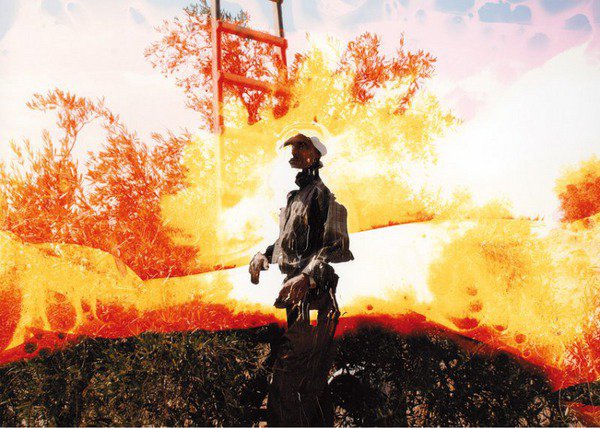James Turrell/ Curtis Mann
dal 10/9/2010 al 22/10/2010
Segnalato da
10/9/2010
James Turrell/ Curtis Mann
Almine Rech Gallery, Bruxelles
Turrell exhibition presents a projection piece from 1968 entitled "Acro Red" and an aperture piece from 1992. It also features two large-scale holograms, as well as "light transmission pieces" created with the help of a physicist by capturing light in the desert. In Mann's most recent works, found photographs of conflicted and historically complex places throughout the Middle East are subjected to a process of selection and erasure.

For the first time, the Almine Rech Gallery, Brussels is presenting a solo exhibition by James Turrell.
Born in Los Angeles in 1943, James Turrell lives and works in Arizona.
After studying psychology and mathematics, he trained in art at the University of California at Irvine in 1965-66 and obtained an MA from the Claremont Graduate School in 1973. He presented his first "projection pieces" at the Pasadena Art Museum as early as 1967. These light projections into a corner of a room or flat against a wall laid the foundations for a body of work that is essentially based on the very matter of light as an artistic medium and on the question of the perception of matter as well as light and colour.
"My work deals with the concrete nature of light, the contact with it. Light is not ephemeral, it is material. Photons are matter, they produce a wave-like phenomenon, like water." (1)
Although Turrell’s artistic approach was little understood at the time, the scientific component of his reflection caught the attention of the County Museum of Art in Los Angeles, which gave him the means to pursue his work through the "Art and Technology Program" together with artist Robert Irwin and perception psychologist Edward Wortz. He would notably create experimental spaces that were either completely black, soundproof or filled with coloured light and explore the impact on our perception. These works anticipate later works created in the seventies and eighties.
In 1979, James Turrell acquired an extinct volcano in the Arizona desert: Roden Crater. After excavation and layout work, he converted the site into an observatory: corridors and spherical spaces offering an itinerary determined by the course of the sun and the moon. Roden Crater being located on Native American land, Turrell naturally became interested in the Hopi Indians’ "kivas", ceremonial chambers used by the Hopi to establish cosmic connections. In 1986 Turrell started work on his "autonomous structures", central-plan constructions freely inspired by Egyptian mastabas, classical domes and the utopian creations of architect Etienne-Louis Boullée.
The James Turrell exhibition at the Almine Rech Gallery, Brussels will be an opportunity to discover a projection piece from 1968 entitled "Acro Red" and an aperture piece from 1992. The exhibition will also feature two large-scale holograms, the last in a series that Turrell has decided to conclude, as well as "light transmission pieces" created with the help of a physicist by capturing light in the desert.
An unconventional and unclassifiable artist, James Turrell incites viewers to look within themselves and question their own perception.
Françoise Claire Prodhon
(1) Excerpt from Rencontres 9: Almine Rech/ James Turrell, Éditions Almine Rech/ Images Modernes, 2005
-------------------
Curtis Mann
For the first time, the Almine Rech Gallery Brussels is devoting an exhibition to recent works by Curtis Mann.
Born in 1979 in Dayton, Ohio, he lives and works in Chicago, Illinois. He was most recently exhibited in the Whitney Biennial, 2010 curated by Francesco Bonami and Gary Carrion-Murayari and recently had a solo exhibition at the Jewish Museum of Contemporary Art in Kansas City, MO.
In Mann’s most recent works, found photographs of conflicted and historically complex places throughout the Middle East are subjected to a process of selection and erasure. By painting on portions of enlarged color photographs with a clear varnish and then bleaching away unprotected portions of the image with household Clorox bleach, new and abstract meanings are sought from appropriated family snapshots, travel photographs, and casual documentations. The photograph is physically and contextually altered; as a result, the work oscilates between image and object, photography and painting, real and imagined.
In a recent interview Mann states, "I am constantly trying to force these found images to function outside of their initial utility and use photography’s inherent, malleable nature as a way of coming to an ulterior understanding of the complex and the unfamiliar. Coming from a mechanical engineering background, I have always been curious about the paper, the chemicals and the inks used to produce photographic images. They are the birth of the image and their manipulation holds a lot of potential for disrupting the powers of the flat, conventional image."
What do we learn from images? How do we come to understand a place or event through the flattened and selective space of a photograph? With important details manipulated, altered and removed, the viewer is encouraged to embrace an exaggerated sense of confusion and anxiety and challenge our learned and subconscious approach to dealing with images.
In a recent essay* Kristen Carter writes, "Everything is at stake in Mann’s work; his art slowly reveals to the viewer the intricate, complex and vulnerable layers embedded in the possibilities and limits of photography and truth."
For his exhibition at the Almine Rech Gallery in Brussels, Curtis Mann will present a selection of new pieces, including large mural grid works, altered panoramic landscapes and haunting distorted figures all made by chemically altering traditionally photographic prints.
Image: Curtis Mann
Almine Rech Gallery
14 Praeterestraat 1050 Brussels
Hours: Tuesday - Saturday 11am - 7 pm and Monday by appointment from 12 - 6pm



